Thursday May 18
We awoke to temps in the 30s and blowing rain, a perfect excuse to drive to McDonalds for egg McMuffins.
It turns out that iron isn't the only thing that Marquette county is famous for. The 1959 movie "Anatomy of a Murder" which starred Jimmy Stewart, Eve Arden, Lee Remick, Ben Gazzara, and directed by Otto Preminger was filmed in Marquette County, and the premiere held at Ishpeming's Butler Theater had all the stars in attendance.
With the weather still cold and rainy, we took a driving tour of the sights in town related to the movie including the author's house, and the Mather Inn where the cast stayed during filming. When we were done, we stopped at the Butler Theater, now an antique mall, and bought a piece of pottery for resale.
We then returned to Cliffs Shaft, met club President John Crady and fellow member Doug Trudell. Doug showed us the club's rock lab which has several rock saws, grinders, and a tumbler. He showed us the work he had been doing, making clocks and bookends with Kona Dolomite and Jaspillite. He even cut one of the South Haven Septarians that I brought to donate to the club. He even offered to show us one of his favorite collecting spots near the National Mine where you can find Geothite (pronounced Gay-a-tite). We said our goodbyes and told Doug we would contact him in the morning to try and go collecting. Next we decided to search for the Ropes Gold Mine dump area. We had two maps showing the location of the area, but hand drawn maps and reality don't always match up. The roads that led to the sight had no signs at all, and the only way I managed to find the location was by combining my county road map with the local maps. We had lunch in the turn around area below the mine. There we noticed large dog tracks, but didn't think much of it, but as we crested the slope we saw a Wolf! It saw us and disappeared down the other side of the plateau. This was the first time either of us had seen a Wolf in the wild, how cool! Up on the plateau ( which is actually the old mine dump, spread out long ago) we saw large Moose tracks. After collecting nice green Talc crystals and Serpentine we went back down a took photos of both Wolf and Moose tracks.
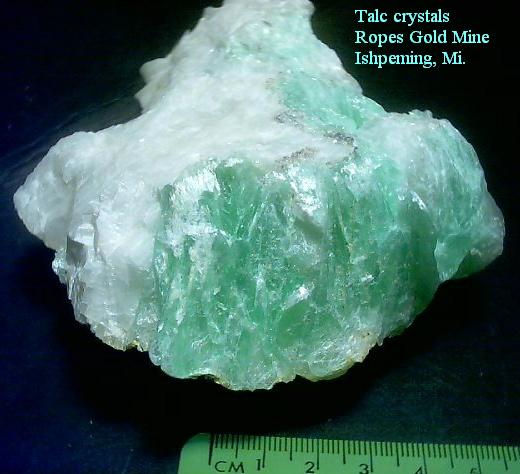
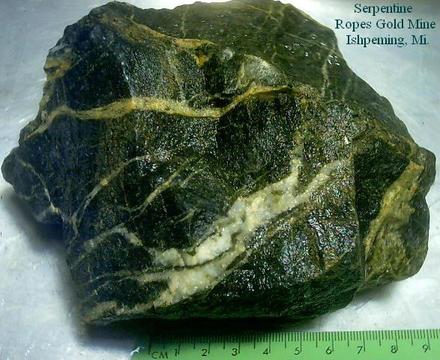
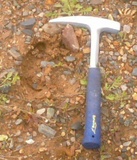
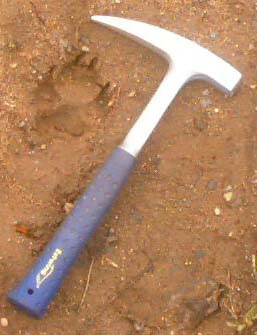
After that we had dinner early and returned the the Champion Mine dump for more collecting. I found "rainbow Hematite" aka "Peacock Ore" aka Bornite-Chalcopyrite and quartz with tiny little grains of garnet, then we returned to camp for the night.
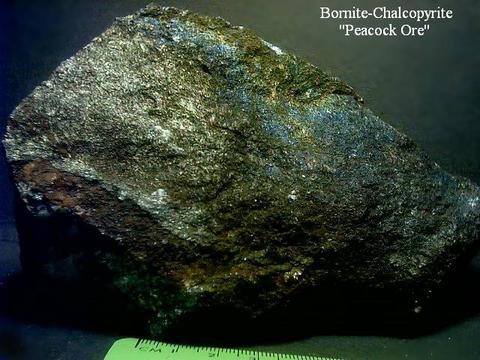
Friday May 19
We awoke to a cold clear morning, had our breakfast, and went to seek out Doug Trudell for a guide to the National Mine area. We couldn't find his house by the directions we remembered so we returned to Cliffs Shaft to see if he was there. He wasn't, but his ex-wife was, so she got him on the phone for me. It turned out that his Mom wanted him to look at her car, so he was waiting for her, but he gave us directions to his house. There he showed us his great mineral collection. Our conversation was interwoven with Doug's tales of rock collecting and his personal problems with the ex-wife. He identified some of our beach rocks, some of which he thought might be agates. It turned out Doug wouln't be able to take us collecting that day, but said he would keep his schedule open for Saturday. We decided to try and get up to Mt. Shasta for some of the Chlorite Pseudo-Garnets I had read about.
First we stopped at the Mt. Shasta Restaurant for lunch. This log cabin style restaurant is one of the locations featured in the movie "Anatomy of a Murder."
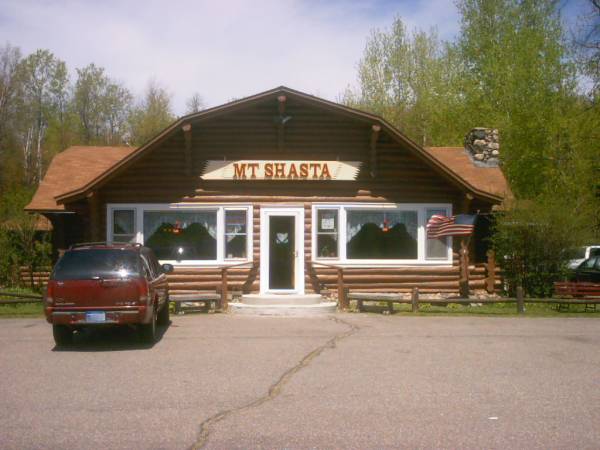
The entrance to the Mt. Shasta Mine dump area is just east of the restaurant. As we entered, another couple was leaving carrying a few of the Garnets we sought. We searched around inside for a little while and a few more people came out from the eastern side so we went over there. I said hi to an Asian gentleman who was on his way out and moved over to the tall pile of loose chlorite gravel and started digging.
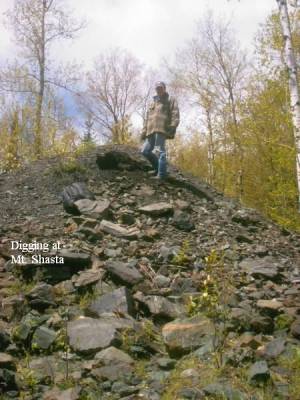
I started having luck on the east side of the pile, digging out several nicely shaped Garnets. At one point I uncovered a little green snake with a yellow belly. It disappeared deeper into the pile, so I decided to let the snake have it's house, and shifted positions down and to the right a little. The more I dug, the more nice Garnets I pulled out. Litha helped spot the ones I missed as I dug through the pile "like a Badger."
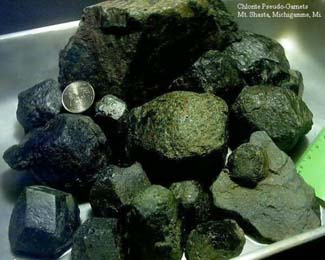
At one point, while trying to knock a Garnet loose from its matrix, the wooden handle of my old sledge broke.
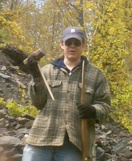
Thanks to warnings on the McRocks website I had been expecting it, and always kept Litha well away when I was using the sledge. Now that it is broken, I'll have to get a sledge that's actually meant to be used on rock.
Eventually the black flies were becoming a swarm, and we'd had enough. We returned to camp to rinse off our finds, then had dinner. After dinner we went on a hike on the path across highway 41 from the Van Riper Park. The trail has burnt wood signs that explain the flora and fawna you might see on the trail including Moose. No Moose were sighted on our hike, but Litha did get her first glimpse of a Beaver in the wild. It splashed it's tail twice and went under. It was a very enjoyable hike after which we went back to camp and turned in.
Saturday May 20
We had heard that Saturday was supposed to be colder and rainy, but awoke to cool but clear skies which quickly warmed up. We had breakfast and drove to the Ishpeming IGA for supplies. We next stopped at the Cliffs Shaft Museum to see of we could get directions to the Baltic Mine near Negaunee. I had heard from two different sources that the massive form of Rhodochrosite could be found there, but when I talked to folks at the museum, no one had heard of it. They had heard of the Baltic Mine up in the Keweenaw, but not around Marquette county. I was told that the only place locally that Rhodochrosite had been found was Lucy Hill, but I would be wasting my time up there, and it was dangerous from cave-ins. In their meeting room we looked at a big map showing all the local mine locations which included former names of the mines. The names changed over time as ownership changed. We found where Lucy Hill was located as well as the North and South Jackson Mine areas. Next we called Doug Trudell to see if we were still on for collecting Geothite. He said to give him 1/2 hour to get ready, then stop over an pick him up. In the mean time Litha and I scouted out the South Jackson Mine. There is a snowmobile/ATV path that runs between Negaunee and Ishpeming that takes you back into the woods to the south. This takes you back where old dump piles can be seen. By then it was time to pick up Doug, so we were off to his house. The South Jackson will have to wait until our next trip.
At Doug's house I showed him the Garnets we found at Mt. Shasta and he seemed pretty impressed. He said the club had a dig up there not too long ago, and most club members hadn't done so well. We then drove not too far away, to his collecting spot. We parked in the yard of an aquaintence of Doug's who's yard backs up to the woodlot where the old mine dump is located. We walked past a big fenced off hole in the ground that used to be the Section Sixteen Mine, and then found the hillside Doug had worked a couple of years ago. We found some small specimens of Geothite, as well as Botryoidal Hematite and Limonite. Doug gave us a couple of pieces he found and kept a nice intact Quartz point he found for himself. The soil in this hillside was red/orange and it took a while to wash that stain from our hands. It was a great dig and we came away with some nice specimens.
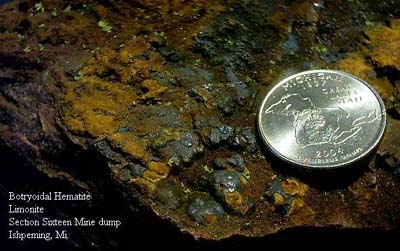
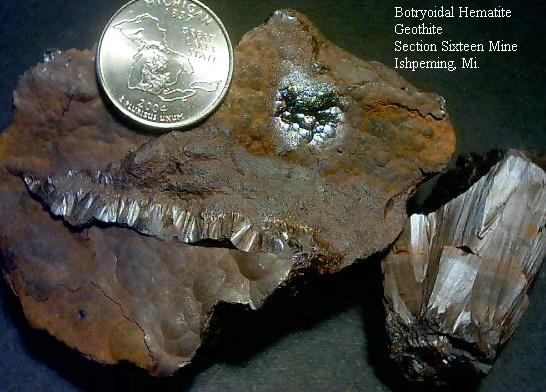
Toward the end of our dig I noticed how it had cooled off and the bugs had gone away. Doug said that was a sign of rain, and he was correct. As we left the collecting sight the rain began to fall. We dropped Doug off back at his house, thanking him profusely. He even let us stock up on decent drinking water, seeing the iron yellow camp water we had been using. His main business right now is selling rocks, so I promised to do some business with him Sunday after the club meeting. We then returned to camp and rested for an hour or so while the rain passed over. When the rain had passed, there was a mixture of clouds and blue sky and it was cooler. That afternoon we returned to Mt. Shasta and dug a few more Garnets. We then returned to camp for dinner, after which the wind was up, the temp was down, and we got the van ready for bed.
Sunday May 21
We awoke to another cold gray windy morning. It was cold enough that we decided to sleep in a little later. When we got up I started the van to get some heat, and we had breakfast. We didn't have any plans for this morning before the Club Meeting, so we decided to find the Luge which is located on and near the Lucy Hill Mine area. Found the finish area of the Luge track where there are a few chalet style cabins. You can even see the winners platform stashed near one of the cabins. We walked down the old asphalt road that takes you past the Lucy Hill Mine dump areas with a mature forest growing out of the top. Litha took my picture near one big cave-in hole.
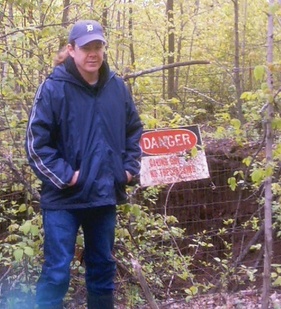
Not long after that it was time for lunch and to get ready for the club meeting.
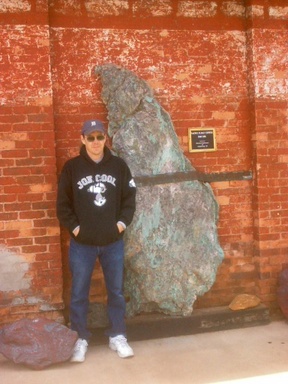
Back at the Cliffs Shaft Museum we entered the rock room which was now bustling with activity. We chatted with several members, greeted Doug Trudell and told him we would see him after the meeting.
I talked with club President John Crady who coincidentally is originally from Davison Michigan, not too far from my hometown of Owosso. His wife is from the Ovid area where Litha works. John said that it was too bad we weren't moving up there. It seemed as though he was looking for someone to groom as a replacement for his position! I told him that I didn't think I was that ambitious. He said neither was he, but the club has a way of "putting their railroad hats on."
The speaker for the day was Paleo Archeologist Jim Paquette. He put on an hour long slide show about his history leading up to his discovery of Jesuit activity in Marquette County. It was a very interesting story how he (himself a descendant of French and local Indian tribes) rediscovered ancient overland trails which led to finding brass Jesuit trade rings from the era of King Louis the 14th from the mid-late 1600s. Before these discoveries, the "learned" authorities believed that activity of the Paleo Indians was limited to the shoreline of the great lakes.
After the presentation John Crady extended an invitation to stay at his house next time we come up. Everyone we met was exceptionally friendly. We cought up with Doug Trudell, looked over his stock of nice Jaspillite, but decided on the Kona Dolomite clock he made, which now hangs on our livingroom wall. I got him to sign the back with a Sharpy marker.
After saying our goodbyes we set out to head back south. Having taken down our awning in the morning, we didn't have to return to Van Riper State Park, so we took 95 south through Republic. Here's a panoramic view of the huge pit at the Republic Mine.

Lake Ellen is, as far as I know, the only location in Michigan with a Kimberlite pipe. Kimberlite is a potentially Diamond and gem quality Garnet bearing volcanic rock that comes from deep in the Earth.
My county map book has a symbol for a campground on public land at Lake Ellen. When we got to the spot on the map there was no camping. I talked to a fisherman who confirmed that we were at that spot on the map, but the map was clearly wrong, or obsolete.
We spent an hour our so driving around more white knuckle logging roads seeking out the notorius Kimberlite Pipe, and we only found one distinct rock outcropping, so I found a few specimens, and we headed off to the next campground in our general direction which turned out to be a State campground at a lake named "Gene's Pond." We were the only ones in camp. In the middle of the night we heard Coyotes howling.
Monday May 22
After an early breakfast, we began the long trek home, nearly losing our way on the back roads of Dickinson County, but eventually making our way to Escanaba and US2. We stopped at a roadside park near my old stomping grounds, Naubinway and the Black River to rest and get a bite to eat. Our next stop was St. Ignace for some of that wonderful fudge, and we stopped for a view of the Mackinac Bridge.
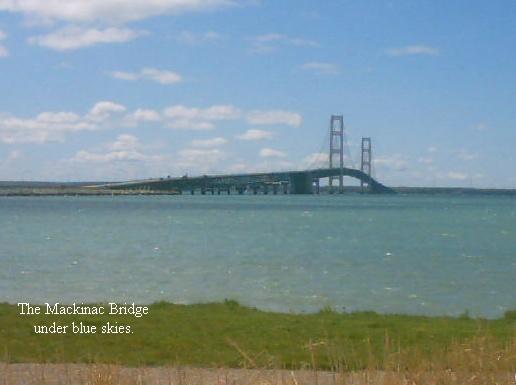
The next five or so hours were thankfully uneventful, and we got back home safe and sound at about 4:00pm. The lawn was a jungle and we really didn't care, we just had a trip of a lifetime. You only do things for the first time once, and this trip was full of firsts.
Jim Adams
CLICK THE LITTLE MINER TO RETURN TO THE FIELD TRIP PAGE
